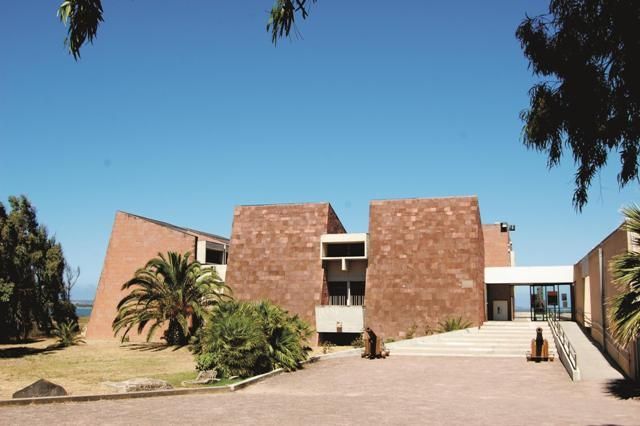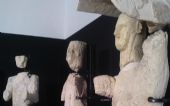
Municipal Museum of Cabras
welcomes Giants Mont'e Prama
Located on the edge of the pond of Cabras, located on the outskirts of the town and jumped on the front pages of magazines around the world to be guardian of the Giants Mont'e Prama, great important discovery of September 2014 in the near namesake site, near Tharros in the Sinis.
In addition to the Giants Mont'e Prama the halls of the museum exhibit a large collection of archaeological finds from the excavations carried out mainly in sites of Tharros and Cuccuru Is Arrius, since the fifties.
The materials of the section dedicated to Cuccuru Is Arrius insediamentale document a sequence that comes from the Middle Neolithic to the Roman period.
The Necropolis of culture Bonuighinu (Middle Neolithic) are exposed accompanying materials, including several female idols volumetric, ceramics, elements necklace, bits of bone and spear geometric microliths in obsidian.
Within the same section, ample space is devoted to the ceramics and stone tools from the villages of San Ciriaco culture (Upper Middle Neolithic), San Michele di Ozieri (Upper Neolithic) and sub-Ozieri (Eneolithic). Characteristic of the cultural phase Ozieri are some idols female and one male in terracotta and marble.
From the temple to the sacred well, reused in the Roman-Republican Formerly an agrarian cult, come of clay statuettes draped female and several other ex-voto. Complete documentation on the installation materials accompanying the necropolis Roman Empire (I-III century AD.) - Based on the corporate website -.
The section reserved for Tharros proposes a framework of archaeological investigations conducted at the site since the last century onwards. Much of the exhibition is devoted to the typical sanctuary Phoenician-Punic tophet, with extensive graphic and photographic documentation that traces the history of the excavation and explains the characters. Numerous clay urns, some with rich painted decoration, and its shell, offering a number of examples of ceramics typical of the sanctuary tharrense. The sandstone stele, exhibited in the central hall of the museum, this category are well crafted with specimens that are among the most distinctive and popular of Tharros. Some small objects found inside the ballot box along with the remains of cremated children and animals, such as amulets and other items of adornment, extend the documentation on the tophet - based on the corporate website -.
Another area is dedicated to the most recent excavations held in the workshop area of ??the village of Cabras. A witness del'intensa metallurgical activity held in the Punic area have emerged here and exposed iron slag, Boccolari and fragments of the walls of the furnaces, as well as ceramic material, fragments of pottery jars and glass paste.
A representation of the ancient city of Tharros del'epoca Roman and paleo-Christian is shown in two large panels, accompanied by several pieces of pottery and stone, among which we highlight heads and marble architectural fragments, findings of excavations held in the years' 50.
Another piece that deserves attention is a milestone in sandstone, found recently in the surrounding countryside of Cabras.
The visit to the museum may end with a stop at botanical species most characteristic of Sinis, exposed and documented with texts and photographs.
Schedules visit to the Museum of Cabras
November 1 - March 31 - hours 9:00 to 13:00 / 15:00 to 19:00 (closed on Mondays)
April 1 - October 31 - hours 9:00 to 13:00 / 16:00 to 20:00 (always open)
It will be closed from December 25 to January 1
In addition to the Giants Mont'e Prama the halls of the museum exhibit a large collection of archaeological finds from the excavations carried out mainly in sites of Tharros and Cuccuru Is Arrius, since the fifties.
The materials of the section dedicated to Cuccuru Is Arrius insediamentale document a sequence that comes from the Middle Neolithic to the Roman period.
The Necropolis of culture Bonuighinu (Middle Neolithic) are exposed accompanying materials, including several female idols volumetric, ceramics, elements necklace, bits of bone and spear geometric microliths in obsidian.
Within the same section, ample space is devoted to the ceramics and stone tools from the villages of San Ciriaco culture (Upper Middle Neolithic), San Michele di Ozieri (Upper Neolithic) and sub-Ozieri (Eneolithic). Characteristic of the cultural phase Ozieri are some idols female and one male in terracotta and marble.
From the temple to the sacred well, reused in the Roman-Republican Formerly an agrarian cult, come of clay statuettes draped female and several other ex-voto. Complete documentation on the installation materials accompanying the necropolis Roman Empire (I-III century AD.) - Based on the corporate website -.
The section reserved for Tharros proposes a framework of archaeological investigations conducted at the site since the last century onwards. Much of the exhibition is devoted to the typical sanctuary Phoenician-Punic tophet, with extensive graphic and photographic documentation that traces the history of the excavation and explains the characters. Numerous clay urns, some with rich painted decoration, and its shell, offering a number of examples of ceramics typical of the sanctuary tharrense. The sandstone stele, exhibited in the central hall of the museum, this category are well crafted with specimens that are among the most distinctive and popular of Tharros. Some small objects found inside the ballot box along with the remains of cremated children and animals, such as amulets and other items of adornment, extend the documentation on the tophet - based on the corporate website -.
Another area is dedicated to the most recent excavations held in the workshop area of ??the village of Cabras. A witness del'intensa metallurgical activity held in the Punic area have emerged here and exposed iron slag, Boccolari and fragments of the walls of the furnaces, as well as ceramic material, fragments of pottery jars and glass paste.
A representation of the ancient city of Tharros del'epoca Roman and paleo-Christian is shown in two large panels, accompanied by several pieces of pottery and stone, among which we highlight heads and marble architectural fragments, findings of excavations held in the years' 50.
Another piece that deserves attention is a milestone in sandstone, found recently in the surrounding countryside of Cabras.
The visit to the museum may end with a stop at botanical species most characteristic of Sinis, exposed and documented with texts and photographs.
Schedules visit to the Museum of Cabras
November 1 - March 31 - hours 9:00 to 13:00 / 15:00 to 19:00 (closed on Mondays)
April 1 - October 31 - hours 9:00 to 13:00 / 16:00 to 20:00 (always open)
It will be closed from December 25 to January 1
-
indirizzo: Via Tharros, 121
-
località: Cabras
-
 0783290636 0783370019
0783290636 0783370019
- Related products
- Cabras
- Giants Mont'e Prama
- Oristano
- Oristano and the province
-
Search
-
Categories
- APP FAITA Sardegna
- HOLIDAY PACKAGES
- CAMPING VILLAGE Sardinia
- Where to eat
- TRANSPORT Sardinia
- BEACHES in Sardinia
- Tours in Sardinia
- KITCHEN traditional Sardinian
- WINES Sardinia
- SPIRITS of Sardinia
- EVENTS in Sardinia
- CORTES Apertas in Sardinia
- SPORT in Sardinia
- MAP Sardinia
- PHOTOS Sardinia
- VIDEO Sardinia
- Useful Numbers Sardinia
- DOGGIE BEACH in Sardinia
- Contact information
- archivio
-
Topics
- Camping e Village Sardinia
- Tourism in Sardinia
- resorts in Sardinia
- Sardinian beaches routes
- Specialties at the table
- South Coast Cagliari
- Costa Rei itinerari
- Ogliastra itinerari
- Nuoro e provincia itinerari
- Gallura itinerari
- Sassari e provincia itinerari
- Oristano e provincia itinerari
- Autunno in Barbagia 2013
- Aerei per la Sardegna
- Traghetti per la Sardegna
- Storia di Sardegna
- Feste e sagre della Sardegna
- Camping Village e Spiagge dog friendly
- Spiagge accessibili con l'amico cane
-
Geo Map
- Sardinia
- Cagliari
- Carbonia-Iglesias
- Medio Campidano
- Nuoro
- Ogliastra
- Olbia-Tempio
- Oristano
- Abbasanta
- Aidomaggiore
- Albagiara
- Ales
- Allai
- Arborea
- Ardauli
- Assolo
- Asuni
- Baradili
- Baratili San Pietro
- Baressa
- Bauladu
- Bidoni'
- Bonarcado
- Boroneddu
- Bosa
- Busachi
- Cabras
- Cuglieri
- Curcuris
- Flussio
- Fordongianus
- Genoni
- Ghilarza
- Gonnoscodina
- Gonnosno'
- Gonnostramatza
- Laconi
- Magomadas
- Marrubiu
- Masullas
- Milis
- Modolo
- Mogorella
- Mogoro
- Montresta
- Morgongiori
- Narbolia
- Neoneli
- Norbello
- Nughedu Santa Vittoria
- Nurachi
- Nureci
- Ollastra Simaxis
- Oristano
- Palmas Arborea
- Pau
- Paulilatino
- Pompu
- Riola Sardo
- Ruinas
- Sagama
- Samugheo
- San Nicolo' D'Arcidano
- San Vero Milis
- Santa Giusta
- Sant'Antonio Ruinas
- Santu Lussurgiu
- Scano Di Montiferro
- Sedilo
- Seneghe
- Senis
- Sennariolo
- Siamaggiore
- Siamanna
- Siapiccia
- Simala
- Simaxis
- Sini
- Siris
- Soddi'
- Solarussa
- Sorradile
- Suni
- Tadasuni
- Terralba
- Tinnura
- Tramatza
- Tresnuraghes
- Ula' Tirso
- Uras
- Usellus
- Villa Sant'Antonio
- Villa Verde
- Villanova Truschedu
- Villaurbana
- Zeddiani
- Zerfaliu
- Sassari
- Sardinia










